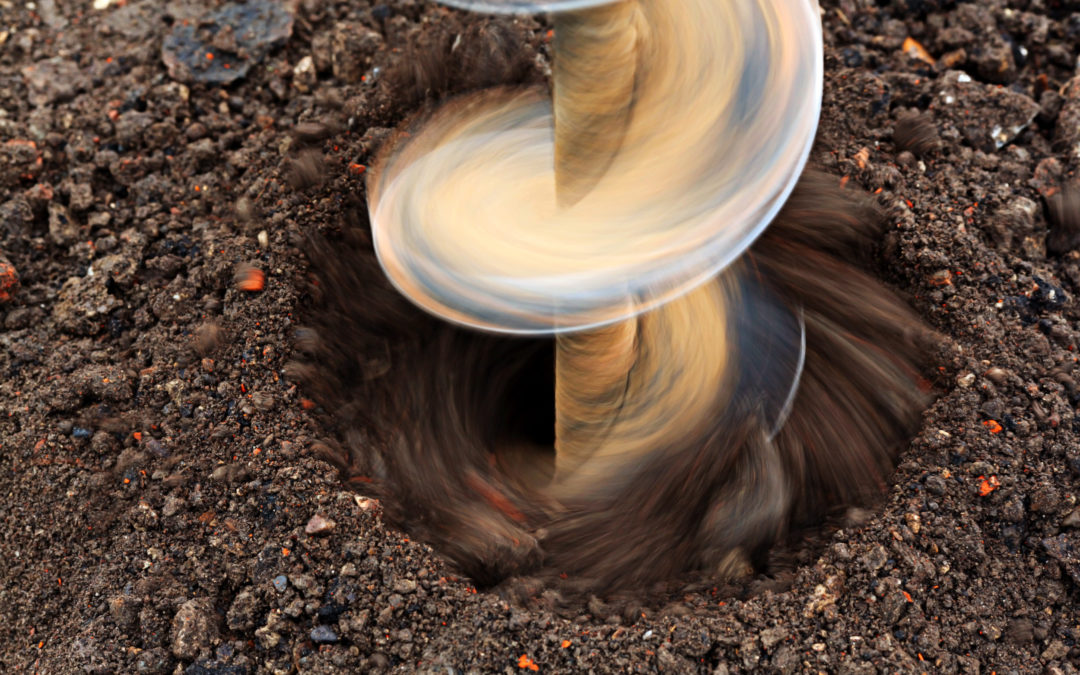Choosing the right tool for the job
If you have a job that requires you to dig a significant number of deep, even holes, a power auger can help make the process incredibly easy. Operating an auger can be about as easy as operating a lawnmower, and will save you a lot of time and effort for fencing or deck installation, or other projects that require deep holes to be drilled. Power augers come in a few varieties and power levels and offer a range of drill bits depending on the intended size of your holes. Here at Pine Valley Rental & Sales, we offer one-person, two-person, and Power Head augers for skid steers.
One-person augers tend to be useful for smaller projects, such as those that involve anchoring certain types of poles and fences. These augers can usually only handle 4-8” auger bits, which will suffice for the majority of typical household projects. If the job you’re undertaking looks to be a bit more involved, graduating to a two-person auger might be the answer. These machines operate just like they sound, using the stability of two people to power and handle the auger as the hole is being drilled. These augers can usually handle bits up to 12,” and come in handy for more involved projects, such as the installation of footings for a deck that will be attached to a home. An auger attachment for a skid steer, on the other hand, is naturally reserved for very labor-intensive projects that require holes to be dug over a large area. This option works best for those looking to develop a large piece of land in a shorter amount of time.
Call Before You Dig!
Although in hindsight this step in the process may seem fairly obvious, it is very important to call your utility companies and have any pipes or lines properly marked. This will prevent the dangerous puncturing of any electrical, gas, or water lines, and also help avoid the headaches from severing your Internet or cable lines. Dialing 811 will bring you to the national hotline that will assist you in determining if any important utility lines lie below your intended location. Pine Valley Rental & Sales can also help provide you with information on this issue. Another issue to consider is whether or not you require a building permit to begin your project. This requirement will ultimately depend on the code determined by your local municipality. Additionally, you may want to contact your HOA to see if you need additional permissions to conduct your project.
How to Properly Use an Auger
Operating an auger by itself is unfortunately usually not enough to get the job done. Try and have these tools on hand as well to handle and rocks, roots, or other objects that will have to be removed to finish digging your holes:
- 6’ Digging Bar
- Shovel
- Post hole digger
Once you have chosen the correct auger for your project, you should begin by marking the locations in which you intend to drill holes. Begin the process by digging a ‘pilot hole,’ which will remove any grass or surface materials that may be difficult to puncture with the auger.
If using a one-person auger, begin by turning on the auger and placing it over the pilot hole. When you engage the throttle, you will feel the auger begin to spin in a clockwise motion. It is important to remember to remove dirt as you go along; otherwise, the auger will be quite difficult to lift out or may even end up stuck underground. The rule of thumb, in this case, is to remove the dirt built up by the digging process every 12″ or so. This process will begin to feel more natural as you continue to dig more holes. Dirt can either be removed by periodically turning off the auger, lifting it out of the hole, and dumping it in a pile on the ground, or by slowing the throttle and slowly lifting the auger out of the hole, which will cause any accumulated dirt to fling off.
A two-person auger functions much in the way that a one-person auger does, the only caveat being that it requires two people to operate. The two-person auger exerts a large amount of torque as it digs through the soil, so therefore operators should prepare by bracing their left shoulders for significant resistance to avoid any mishaps.
To ensure that your auger remains in good operating condition, leave it upright in one of the holes when it’s not in use. If that’s not an option, you can also lay it on the ground with the spark plug facing up to prevent what is known as “fouling,” which can result in engine misfiring.
Operating a Power Head auger attached to a skid steer is a much more complicated procedure which will require prior knowledge of skid steer operation and significant experience with construction equipment.
Safety Concerns
In addition to calling before you dig, there are several safety concerns to take into account. Before you even begin your project, make sure to have eye and ear protection. While it may seem unnecessary, augers can be quite loud and tend to fling debris all over the place, which can be dangerous at times. Definitely opt for closed-toed shoes, preferably steel-toed boots if you have them. A good pair of work gloves will also reduce the wear on your hands and help you reduce the vibration and torque of the auger. Finally, ensure that you’re not wearing any loose or dangling objects that may get tangled up in the auger bit.
While using an auger for the first time may seem daunting, they are often very manageable and end up saving you time and energy in the long run. Stop by Pine Valley Rental & Sales in Bayfield, CO or Pagosa Springs, CO and we’ll provide you with the tools and expertise you need!
Sources:
http://www.tractorsupply.com/know-how_farm-ranch_fencing_how-to-properly-use-a-power-auger
http://www.familyhandyman.com/tools/power-tools/using-a-power-auger/view-all#step1

